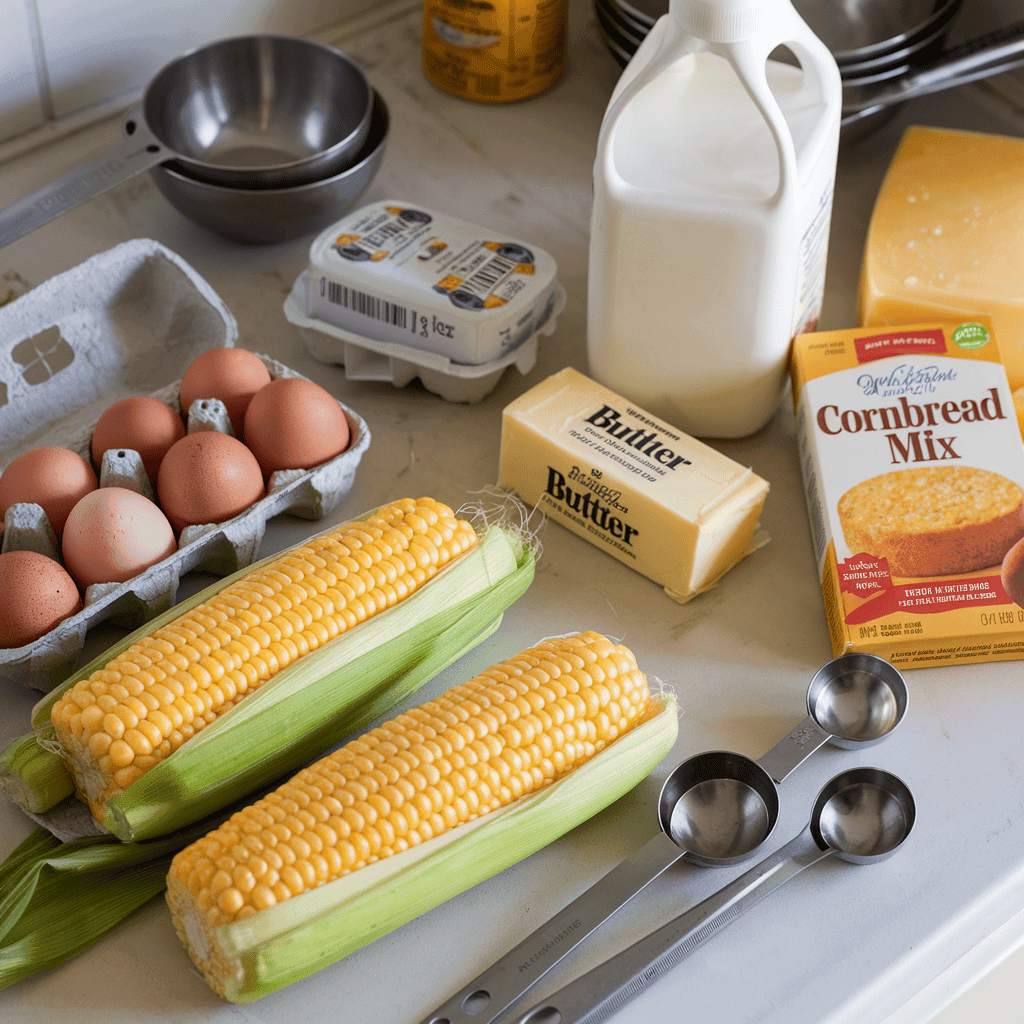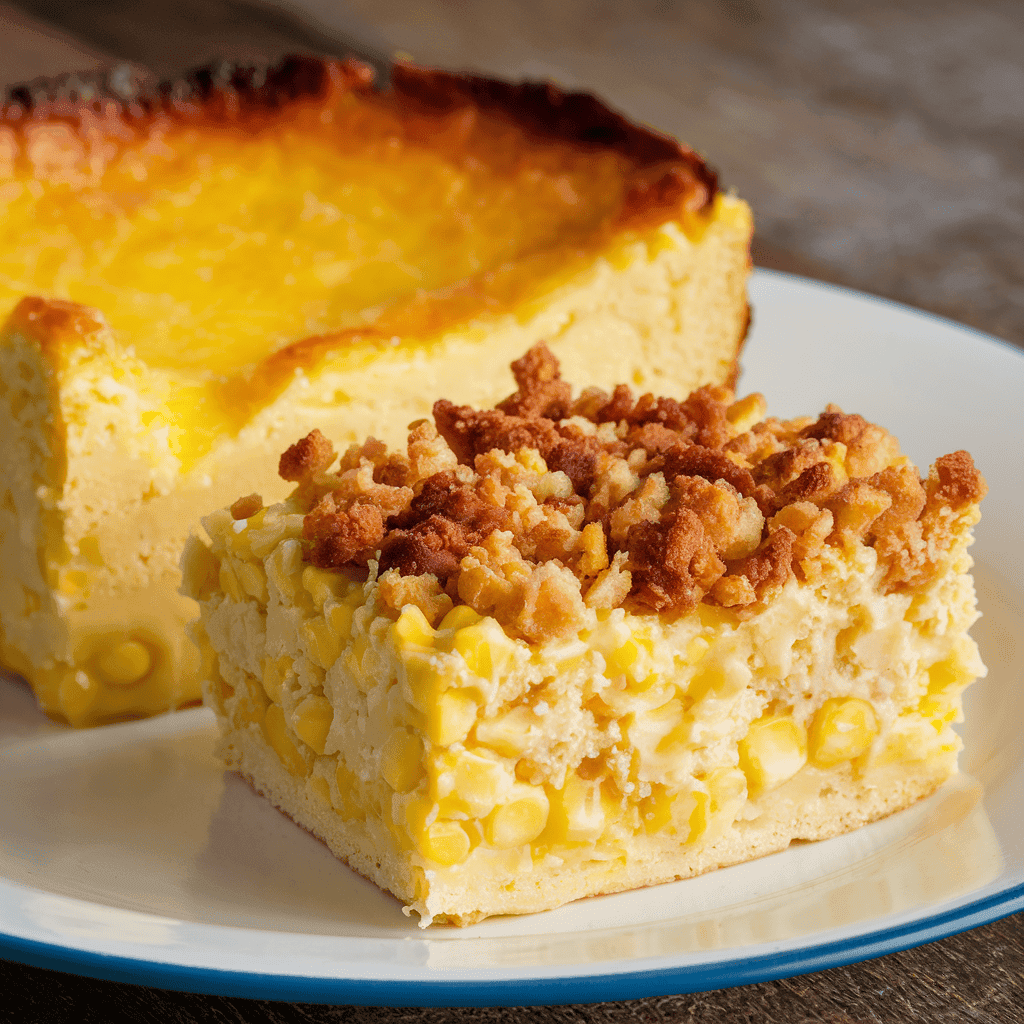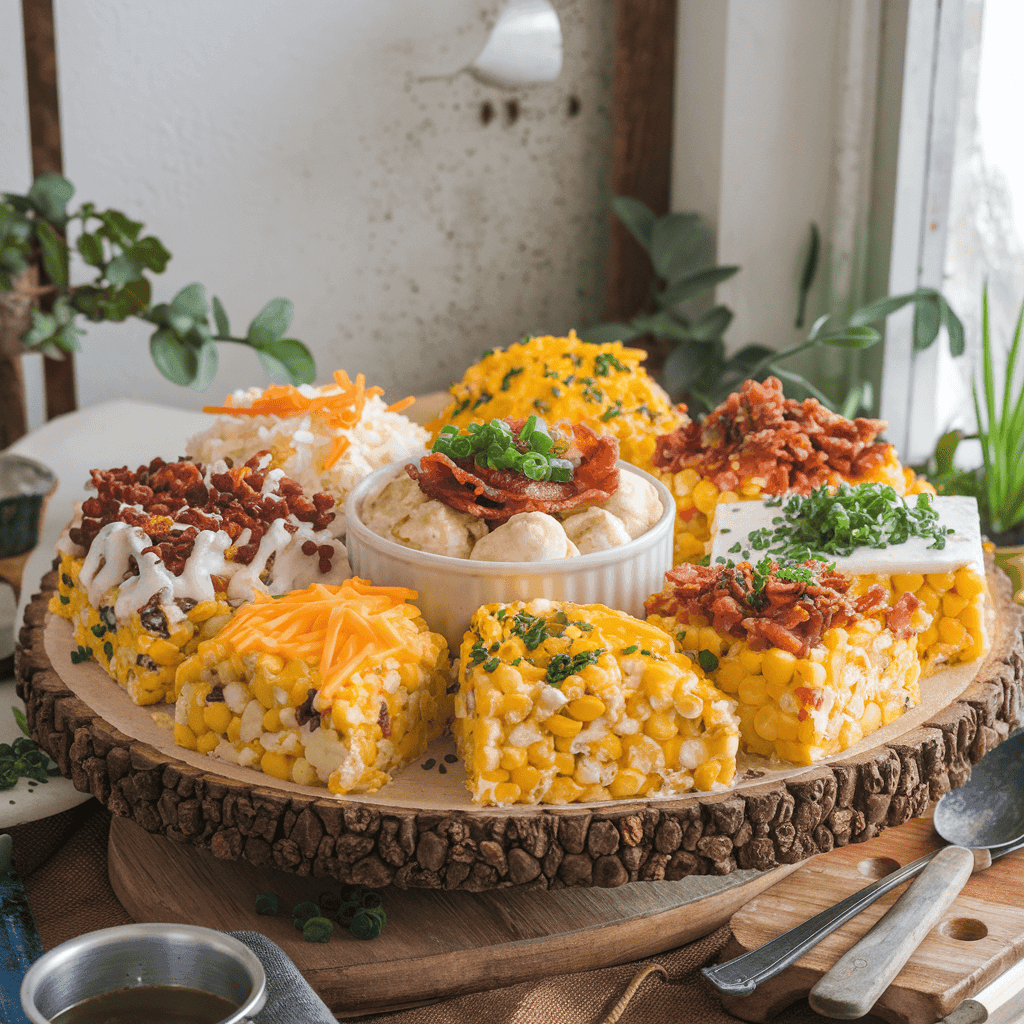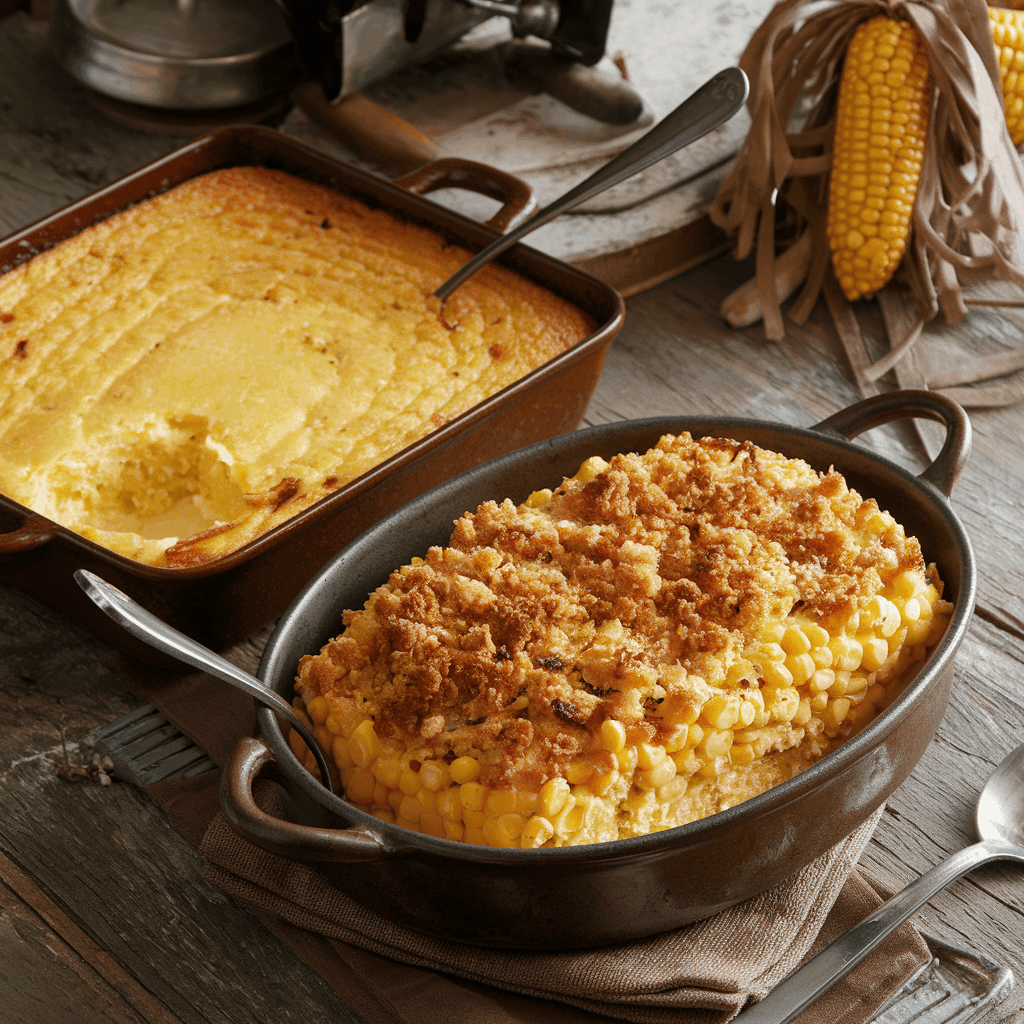Corn Pudding vs Corn Casserole: What makes these classic corn-based dishes different? While both feature corn as a star ingredient, they vary in texture, preparation, and the occasions they’re served. In this article, we’ll explain the differences to help you decide which one fits your next meal or holiday gathering.
Table of contents
Definition and Origins
What Is Corn Pudding?
Corn pudding is a classic comfort dish that originated in the American South. Its roots trace back to Native American cuisine, where corn was a dietary staple. Early settlers adapted Native recipes by incorporating dairy products, eggs, and sugar to create a rich, custard-like dish that’s both savory and slightly sweet.
This dish is traditionally baked and features a soft, creamy consistency. In fact, the texture is similar to a thick custard, making it a perfect side dish for holiday meals like Thanksgiving or Christmas. As a result, corn pudding has become a cherished comfort food in many households. Moreover, it is often considered a heritage dish, frequently passed down through generations in Southern families.
What Is Corn Casserole?
Corn casserole, also known as corn bake or scalloped corn, has a heartier texture than corn pudding. Its origins can be traced back to Midwest and Southern cooking traditions, where casseroles became a popular way to create filling, satisfying meals with minimal ingredients.
The dish typically includes a base of creamed corn, whole-kernel corn, and a binding agent like cornbread mix or flour. Corn casserole is thicker, denser, and has a firmer structure compared to the creamy texture of corn pudding. It’s often topped with cheese, breadcrumbs, or crackers for extra crunch and flavor.
Historical and Cultural Significance
The Cultural Roots of Corn Pudding
Corn pudding has deep historical roots in American culinary traditions, particularly in the South. Its origin can be traced back to Native American cultures, where corn was a primary food source. Early Native Americans used corn in many forms, including ground cornmeal and hominy. They shared their corn-based recipes with European settlers, who adapted these dishes by adding ingredients such as milk, eggs, and sugar, creating what we now recognize as corn pudding.
In Southern cuisine, corn pudding evolved into a beloved comfort food, often associated with holidays and special family gatherings. Consequently, the dish has come to symbolize warmth, hospitality, and tradition. Furthermore, many Southern families have unique recipes passed down through generations, each reflecting personal touches such as added spices, cheeses, or herbs.
The Cultural Legacy of Corn Casserole
Corn casserole, while less rooted in historical folklore than corn pudding, has become a staple of American comfort food cuisine. Its rise in popularity coincided with the mid-20th century, when convenient, packaged ingredients like canned corn, boxed cornbread mix, and condensed soups became common in American households.
This dish’s simplicity and versatility helped cement its place in home-cooked meals, especially in the Midwest and South. It became a potluck favorite due to its easy preparation and ability to feed large groups. Today, corn casserole is considered a quintessential comfort food, often appearing at Thanksgiving dinners, church suppers, and community events.
How These Dishes Became Holiday Favorites
Both corn pudding and corn casserole have become iconic dishes during holiday celebrations in the U.S., particularly Thanksgiving, Christmas, and Easter. Their inclusion on holiday menus is driven by their hearty, satisfying nature and their compatibility with traditional holiday flavors like turkey, ham, and roasted vegetables.
Corn pudding, with its rich, custard-like texture, often serves as a balance to savory and salty dishes on the holiday table. In contrast, corn casserole, with its dense, bread-like consistency, acts as a filling, carb-heavy side that pairs well with a variety of main courses. Therefore, both dishes complement holiday feasts by adding distinct textures and flavors to the meal.
Corn pudding, with its rich, custard-like texture, often serves as a balance to savory and salty dishes on the holiday table. In contrast, corn casserole, with its dense, bread-like consistency, acts as a filling, carb-heavy side that pairs well with a variety of main courses. As a result, both dishes complement traditional holiday spreads, offering different textures and flavors.
Why These Dishes Endure
The enduring popularity of corn pudding and corn casserole can be attributed to several factors:
- Affordability: Both dishes use inexpensive, widely available ingredients.
- Simplicity: Their recipes are straightforward and easy to follow.
- Customization: Home cooks can adapt the dishes with various add-ins and flavors.
- Tradition: They are linked to cherished holiday memories and cultural heritage.
These factors explain why corn pudding and corn casserole continue to be beloved in American homes, ensuring their legacy for future generations.
Ingredients Comparison in Corn Pudding vs Casserole
Key Ingredients in Corn Pudding vs Casserole
Despite their differences, corn pudding and corn casserole share several common ingredients, including:

- Corn: Both use creamed corn and whole-kernel corn.
- Eggs: These provide structure and help the dishes set.
- Milk or Cream: Adds richness and moisture.
- Butter: Enhances flavor and keeps the dishes tender.
Unique Additions in Corn Pudding vs Casserole Recipes
Corn Pudding:
- Sugar: Often added for sweetness.
- Flour or Cornstarch: Used sparingly for thickening.
Corn Casserole:
- Cornbread Mix or Flour: Essential for the casserole’s thick, bread-like texture.
- Cheese: Commonly added for extra flavor.
- Toppings: Breadcrumbs or crackers for a crunchy crust.
Texture and Appearance of Corn Pudding vs Casserole
Texture of Corn Pudding vs Casserole: What’s the Difference?
Corn pudding is known for its soft, custard-like consistency. The mixture of corn, eggs, milk, and butter creates a creamy, almost soufflé-like dish. When properly baked, corn pudding should be tender and moist, with a slightly jiggly center that firms up as it cools.
The smooth texture comes from blending creamed corn with liquid ingredients, while whole-kernel corn adds a slight bite. This balance between creamy and tender makes corn pudding a popular side dish, complementing savory mains like roast turkey or glazed ham.

How Corn Pudding vs Casserole Feels When Baked
Corn casserole has a thicker, denser consistency, thanks to its inclusion of cornbread mix or flour. The baked result is firm, sliceable, and somewhat cake-like. It holds its shape well, making it easy to serve in squares or wedges.
The surface of corn casserole often has a golden-brown crust, sometimes enhanced by melted cheese, breadcrumbs, or even crispy onions. Inside, the texture is moist but firm, with visible kernels of corn adding a pleasant chewiness. This heartier texture makes it ideal for potlucks, barbecues, and family gatherings.
Cooking Methods for Corn Pudding vs Casserole
How to Make Corn Pudding
- Ingredients Needed:
- Whole-kernel corn (canned or fresh)
- Creamed corn
- Eggs
- Milk or heavy cream
- Sugar (optional, for sweetness)
- Butter (melted)
- Flour or cornstarch (for thickening)
- Preparation Steps:
- Preheat the Oven: Set it to 350°F (175°C).
- Mix Wet Ingredients: Whisk together eggs, milk, melted butter, and sugar.
- Add Corn and Flour: Stir in whole-kernel corn, creamed corn, and a bit of flour or cornstarch to thicken.
- Bake: Pour the mixture into a greased baking dish and bake for 45-60 minutes until golden brown and set. The center should still be slightly jiggly but not liquid.
How to Make Corn Casserole
- Ingredients Needed:
- Whole-kernel corn (drained)
- Creamed corn
- Cornbread mix (such as Jiffy)
- Sour cream
- Eggs
- Butter (melted)
- Optional: Cheese, bacon, jalapeños, or green onions
- Preparation Steps:
- Preheat the Oven: Set it to 350°F (175°C).
- Combine Ingredients: In a large bowl, mix creamed corn, whole corn, cornbread mix, sour cream, eggs, and melted butter.
- Pour and Bake: Transfer the mixture to a greased baking dish and bake for 45-55 minutes. The edges should be golden, and a toothpick inserted into the center should come out clean.
- Add Toppings (Optional): If using cheese or breadcrumbs, sprinkle them on top during the last 10 minutes of baking for a bubbly, crispy crust.
Corn Pudding vs Casserole: Serving Suggestions
How to Serve Corn Pudding vs. Corn Casserole
Corn pudding is a versatile side dish that pairs well with a variety of main courses. Because of its creamy, slightly sweet flavor, it complements savory meats, making it a popular addition to holiday meals, potlucks, and family dinners. Moreover, its comforting texture and rich taste make it suitable for both casual gatherings and formal celebrations.

- Best Occasions: Thanksgiving, Christmas, Easter, and family gatherings.
- Main Course Pairings:
- Roasted Meats: Turkey, ham, pork tenderloin, or roast chicken.
- BBQ Favorites: Pulled pork, grilled chicken, or ribs.
- Vegetarian Pairings: Mixed green salads, roasted vegetables, or a hearty bean-based dish.
- Presentation Tips: Serve directly from the baking dish or scoop into individual ramekins for a more elegant presentation.
How to Serve Corn Casserole
Corn casserole’s denser, more filling texture makes it a hearty side dish, especially suitable for casual gatherings, potlucks, and even weeknight dinners. Additionally, its savory, cornbread-like consistency provides a satisfying contrast to saucy or spiced main dishes. As a result, it has become a staple at family meals and festive celebrations alike.
- Best Occasions: Summer barbecues, Thanksgiving, potlucks, and family meals.
- Main Course Pairings:
- Grilled Meats: Barbecue ribs, brisket, grilled chicken, or burgers.
- Comfort Foods: Meatloaf, fried chicken, or baked ham.
- Vegetarian Options: Pair with black bean chili, roasted squash, or a veggie casserole.
- Serving Suggestions: Slice into squares for easy serving. Add fresh herbs like parsley or chives for a touch of color.
Nutritional Differences
Caloric Content and Nutritional Value
While corn pudding and corn casserole share some ingredients, their nutritional profiles differ due to variations in preparation and added components.
- Corn Pudding:
- Calories: Slightly lower due to its custard-like base.
- Fat: Contains less fat unless extra butter or cream is added.
- Sugar Content: Higher if sweetened for a dessert-like flavor.
- Protein: Moderate, thanks to eggs and dairy.
- Corn Casserole:
- Calories: Higher due to cornbread mix, cheese, and optional toppings.
- Fat: Increased from butter, cheese, and sour cream.
- Carbohydrates: More carb-heavy due to the cornbread base.
- Protein: Slightly higher with cheese and eggs.
Dietary Adjustments and Healthier Options
- Gluten-Free Substitutions: Use gluten-free cornmeal or baking mixes.
- Dairy-Free Alternatives: Substitute plant-based milk, butter, and sour cream.
- Lower-Calorie Adjustments: Reduce butter, use low-fat dairy, or skip sugary toppings.
- Vegetarian/Vegan Modifications: Use flax eggs, vegan butter, and non-dairy milk for a plant-based version.
Popular Variations of Corn Pudding vs Casserole
Corn Pudding Variations
Corn pudding’s adaptable nature makes it easy to customize for different flavor profiles. Consequently, home cooks can experiment with various ingredients to create unique versions. Below are some popular twists on the classic recipe:

- Sweet Corn Pudding:
- Add-ins: Brown sugar, cinnamon, and nutmeg for a dessert-like version.
- Serving Tip: Serve warm with a drizzle of maple syrup or honey.
- Savory Corn Pudding:
- Add-ins: Cheddar cheese, chopped jalapeños, and green onions.
- Serving Tip: Pair with spicy main courses for a flavorful contrast.
- Bacon and Cheese Corn Pudding:
- Add-ins: Crispy bacon bits and shredded cheese.
- Serving Tip: Top with extra bacon before serving for added crunch.
- Herb-Infused Corn Pudding:
- Add-ins: Fresh thyme, rosemary, or chives for a herbaceous flavor.
- Serving Tip: Great as a side for roasted meats and holiday feasts.
Corn Casserole Variations
Similarly, corn casserole is just as versatile, offering plenty of room for customization based on taste and occasion. As a result, it can be adapted with various ingredients to suit different preferences and meal types:
- Cheesy Corn Casserole:
- Add-ins: Extra cheddar, Monterey Jack, or pepper jack cheese.
- Serving Tip: Sprinkle additional cheese on top during the last 10 minutes of baking.
- Mexican-Style Corn Casserole:
- Add-ins: Chopped green chilies, taco seasoning, and a sprinkle of cotija cheese.
- Serving Tip: Serve with sour cream, salsa, and chopped cilantro.
- Vegetable-Loaded Corn Casserole:
- Add-ins: Bell peppers, zucchini, and chopped spinach.
- Serving Tip: This veggie-packed version works well with grilled meats or vegetarian mains.
- Meat Lover’s Corn Casserole:
- Add-ins: Ground sausage, cooked bacon, or diced ham.
- Serving Tip: Serve as a hearty main dish for brunch or dinner.
FAQs
Frequently Asked Questions About Corn Pudding and Corn Casserole
- Can I make corn pudding or corn casserole ahead of time?
- Answer: Yes, both dishes can be prepared in advance. Assemble the ingredients, cover, and refrigerate for up to 24 hours before baking.
- What’s the main difference between corn pudding and corn casserole?
- Answer: Corn pudding is custard-like and creamy, while corn casserole is thicker and bread-like due to the addition of cornbread mix.
- Can I freeze leftover corn pudding or corn casserole?
- Answer: Yes, both dishes freeze well. Allow them to cool completely, wrap tightly, and freeze for up to 3 months. Reheat in the oven for the best texture.
- Is corn pudding gluten-free?
- Answer: Traditional corn pudding is often gluten-free if no flour or cornbread mix is used. Check specific recipes for gluten-containing ingredients.
- Can I make these dishes dairy-free?
- Answer: Absolutely! Use dairy-free milk, butter, and sour cream alternatives to adjust for dietary needs.
- What’s a good topping for corn casserole?
- Answer: Cheese, breadcrumbs, crushed crackers, or crispy fried onions are popular toppings that add flavor and texture.
Conclusion
Corn Pudding vs Casserole are beloved comfort foods that shine at family gatherings, holiday feasts, and potluck dinners. While corn pudding offers a sweet, custard-like experience, corn casserole delivers a hearty, bread-like texture. Understanding their unique ingredients, preparation methods, and serving suggestions can help you choose the perfect dish for any occasion—or inspire you to try both!

